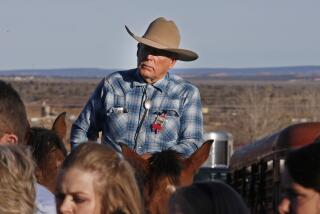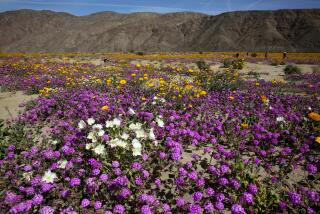It’s where the buffalo can roam
- Share via
PAWHUSKA, OKLA. — It’s 6 a.m., and the cowboys are already downing second and third cups of coffee, adjusting to a 35-degree morning. Slowly, a full moon and stars give way to hues of orange sky. And with daybreak, what had been obscured comes into clearer focus: hundreds of shaggy bison standing on an unfenced landscape that looks like it rolls on forever.
Any other time of year, this herd of 2,600 would have a 23,000-acre swath of the Tallgrass Prairie Preserve to roam.
But for one week in November, it’s time for the annual roundup in this place where man took a 5,500-year-old species to the brink of extinction and brought it back.
The 21st century cowboys who round up the animals employ pickups and ATVs instead of horses to thin the herd. Some bison will be sold to private ranchers and some trucked to slaughterhouses.
It’s the 15th roundup since 300 bison were reintroduced to the tallgrass prairie in the early 1990s. Overseen by the Nature Conservancy, which bought the preserve in 1989, the program here is among several across the country that have rescued the American bison -- also commonly called the buffalo -- from near-annihilation.
With predators largely gone and uncontrolled hunting now long past, the roundup keeps the herd in healthy balance, says preserve official Bob Hamilton.
“We are the predator; we are the wolf,” he says.
Just 120 years ago, about 500 bison remained in the U.S., slashed from a peak of at least 30 million by game hunters, European settlers and railroad crews. Government policy supported the mass killing as a way to subdue American Indian tribes, which used nearly every part of the animal.
Bison were slaughtered by the thousands for their tongues, hides and bones, the bulk of their carcasses left to rot.
In his 1889 work, “The Extermination of the American Bison,” zoologist William T. Hornaday offered a glimpse of the devastation:
“With the building of three lines of railway through the most populous buffalo country there came a demand for robes and hides . . . and then followed a wild rush of hunters . . . eager to destroy as many head as possible in the shortest time.
“For those greedy ones, the chase on horseback was too slow and too unfruitful. That was a retail method of killing, whereas they wanted to kill by wholesale,” he wrote.
Instead of hunting on horseback with bow and arrow, as the Indians did, shooters employed the still-hunt method: sneaking up on a herd, perhaps positioning on a ridge overlooking a prairie, taking aim with rifles and downing as many as they could.
Old photos and paintings are testament to the carnage. One picture in Hornaday’s book, captioned “Five Minutes’ Work,” shows eight bison lying dead on the prairie, the shooter’s horse standing to the side. A black-and-white photograph from the late 1800s shows a man standing atop a mountain of bison skulls.
As the bison suffered, so did the tallgrass prairie, which once encompassed 142 million acres and stretched from Canada to the Gulf of Mexico. Today, one-tenth of that prairie remains, the largest of it in the Flint Hills of Oklahoma and Kansas.
Before reintroduction of the species in recent years, the last recorded bison on the tallgrass prairie was in northern Osage County, Okla., in 1851. It was killed by a survey crew.
“It’s appalling that we really decimated the wildlife,” laments Harvey Payne, who’s been involved with the preserve for about 25 years.
The other red meat
Today, bison are no longer in danger of extinction.
With more than 500,000 living in North America, the animals can be found on private ranches, public parks -- such as Yellowstone in Wyoming -- and wildlife preserves like the tallgrass prairie, about 80 miles northwest of Tulsa. About 5,600 can be found on conservancy preserves in the Great Plains.
Perhaps the most famous bison owner is media mogul Ted Turner, who has about 50,000 head and manages 2 million acres of ranch land.
He’s parlayed that into dozens of namesake restaurants that serve up the lean, low-calorie meat. His Ted’s Montana Grill locations offer bison meatloaf and bison pot roast, among other dishes.
Bison meat has gained in popularity in specialty supermarkets and burger joints across the country, and its health appeal is winning new converts.
A selling point: From ranch to dinner plate, your meal is 100% organic.
“It’s the exact thing Lewis and Clark would’ve eaten,” says M. Sanjayan, lead scientist at the conservancy. “You’re not going to get more pure than that.”
Six pickups are on the move. A twangy country tune blasts out one of the windows.
One is equipped with a glass-pack muffler, and its throaty roar is effective when bison are being moved down the corral alley.
The vehicles box in a few hundred of the animals -- a perfect day’s haul.
A kick like a mule’s
Though bison have a reputation for being a slow, plodding animal without much brainpower, it is myth.
A year ago here, an agitated bison flipped over an ATV like a child’s toy. It’s estimated an animal can travel 35 miles an hour if it has to. And, during roundup time, bison get really nervous -- and unpredictable -- in close quarters.
“This is a wild species that grew up tossing grizzly bears off their backs,” Sanjayan says. “It’s like herding rhinos.”
Within minutes, a phalanx of stomping, grunting brown beasts heads for the corral, the trucks giving close chase.
Steam rises off the animals’ thick fur. The bison are coming, and they are not amused.
“They kick like a Missouri mule,” Payne warns anyone within earshot.
Groups of grunting bison are led through the maze-like corral. Calves are sorted and worked separately.
Perched on narrow walkways rimming the steel corral, the cowboys use plastic “rattle paddles” with tiny beads inside and cattle prods to direct the animals into smaller and smaller areas until there is room for just one to go through at a time.
“Electroshock therapy,” jokes one cowboy, attempting to motivate a 1,500-pound bull into the narrower pen.
“That ol’ boy’s worked up,” his buddy chimes in.
The bull grunts, as if acknowledging his statement.
The sun is barely up, and the first half of the day’s roundup is in the queue.
After navigating the labyrinthine system of pens, the bison arrive at the final step. Electronic transponders attached to each animal’s ear are scanned with wands, and each one’s unique 15-digit number is relayed to a computer, which displays sex, origin and age, among other data.
This fall, about 450 will be culled from the herd. Bulls are sold at 6 and 7 years old; cows at 10 to 12. They might be used as breeding stock, or be on their way to the dinner table.
“We have a pretty good grip on what the sex and age structure of our herd is, how many animals we have out there,” says Hamilton, the preserve director. “So, before roundup, all those godlike decisions are made on who stays and who goes so that it can be as efficient as possible.”
At a stopping point, the cowboys take a load off.
One of the elders, 74-year-old Jack Cheves, wearing a weathered cowboy hat, has been in the cattle business all his life and worked the first bison roundup here.
He remembers when some of the locals were uneasy after the conservancy first bought this preserve, worried about the future of their ranches. They’ve since come around.
As for the cowboys, they look forward to each year’s roundup, he says.
“It’s just a way of life.”
More to Read
Sign up for Essential California
The most important California stories and recommendations in your inbox every morning.
You may occasionally receive promotional content from the Los Angeles Times.










